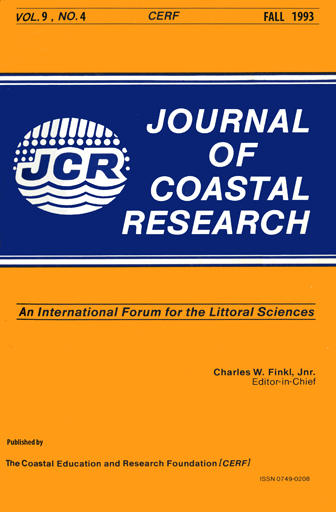Seasonal Measurements of Sediment Elevation in Three Mid-Atlantic Estuaries
Keywords:
Sediment elevations, long-term measurements, estuaries, estuarine geomorphology, spatial variability, intertidal marshesAbstract
Relative sediment elevations have been measured seasonally since Spring, 1990, in three estuaries representing a range of estuarine geomorphologies, sizes, and watershed inputs: the North Inlet estuary, South Carolina (SC), the Patuxent River estuary, Maryland (MD), and the Rhode River estuary, Maryland (MD). Sediment elevations were quantified using a levelling-arm device that allowed accurate, repeatable measurements at four arm orientations per site (with nine replicates per orientation), a number of habitat sites per location, and a number of locations in each estuary. This hierarchical design allowed variability to be partitioned into nested spatial scales. At North Inlet, we established six locations characterizing a range of freshwater and oceanic influences, and marsh ages. Water level gauges continuously recorded inundation rates at three of the six locations. Six sediment elevation locations along the Patuxent River estuary (one habitat site each) differentiated tributary marshes from main channel marshes, marshes from mudflats, and upper from lower river geomorphologies. Seven sediment elevation sites in the Rhode River estuary were all within the same 0.25 ha area (spatially equivalent to a single habitat site in the other two estuaries), and we used these data to investigate small-scale variability in brackish marsh sediment elevations over time. Results from North Inlet showed sediment elevations increasing at the greatest rates at locations nearest to freshwater influence. These rates were two to three times apparent sea level rise (ASLR), which is 2-4 mm yr -1 in all three estuaries. Sediment elevations in dead end tidal creek marshes - those without direct freshwater inputs - generally increased at rates comparable to ASLR. Geologically older marshes showed little or no net accretion over 2.5 years. A large decline in sediment elevations (-9.4 mm yr -1) at a mudflat located in the headwaters of a geologically young tidal creek appeared to represent the "birth" of a transgressive subtidal creek from an intertidal mudflat. Sediment elevations generally increased at the Patuxent River tributary marsh sites, but at greater rates in lower river than upper river tributaries. In contrast, a lower river main channel marsh and upper river mudflat appeared to be eroding while a middle river marsh and mudflat appeared to be accreting. This pattern suggests that the extensive mid-channel tidal freshwater marshes of the upper river and the isolated tributary headwater marshes of the lower river may be sediment sinks, while others may be sediment sources. The Rhode River study, on the other hand, showed that small-scale variability in brackish marsh sediment elevations may be much greater than seasonal or long-term differences. The consistent use of this accurate and repeatable technique to quantify estuarine sediment elevation dynamics in a number of systems will continue to generate data critical to future comparisons of Atlantic and Gulf Coast estuaries.


